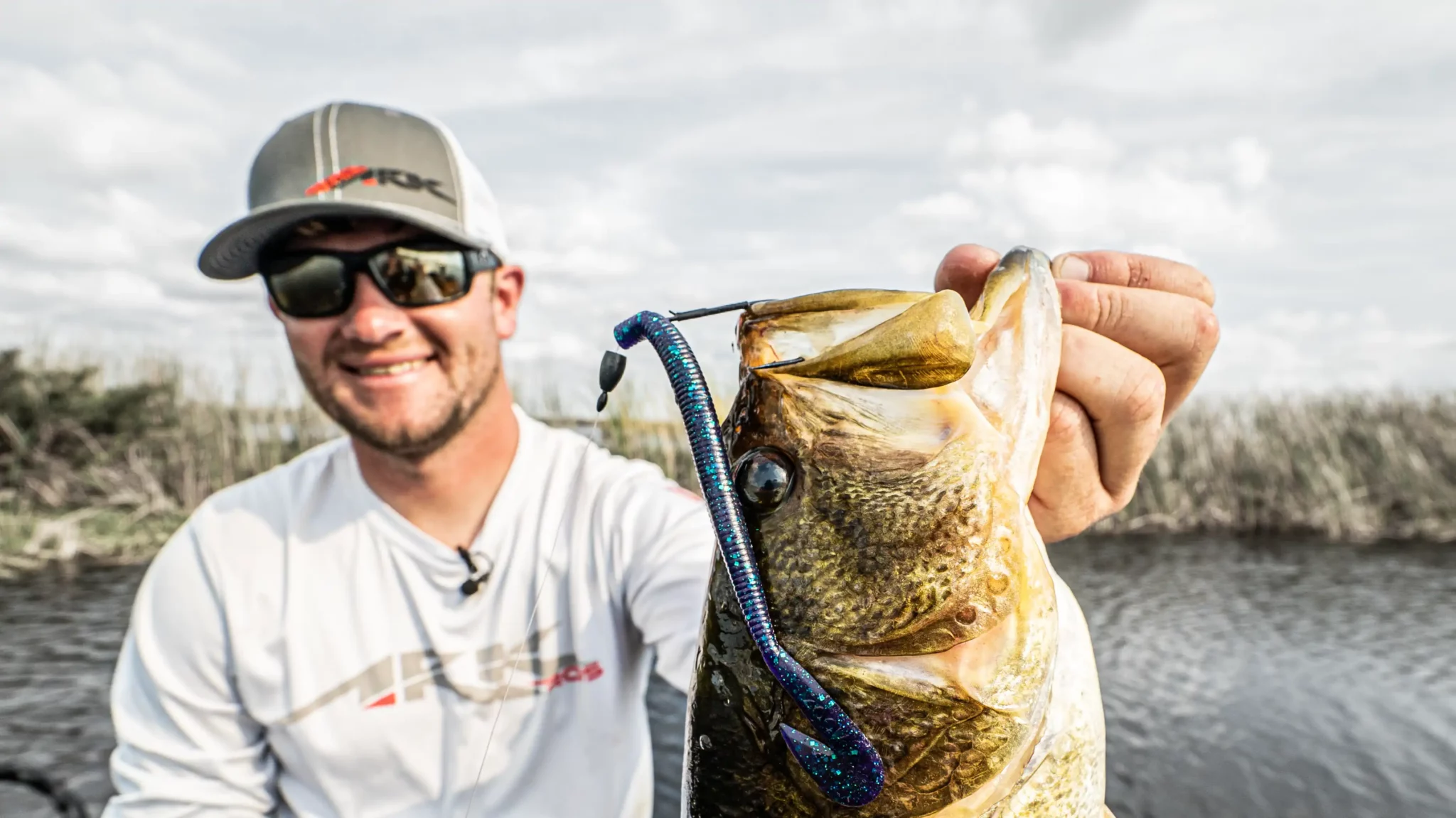Swimming a worm such as the Zoom Speed Worm is an excellent tactic for fishing expansive grass flats. When rigged correctly, it allows you to cover loads of water with minimal fowling. Pro bass angler Wes Logan shows us how to fish the Zoom Speed Worm through scattered hydrilla in open water. The tactic also works well in most grass types anywhere in the country, so long as it isn’t too thick.
FEATURED TACKLE (retail links)
- PLASTIC – Zoom Ultravibe Speed Worm, color – Junebug Buy at Omnia Fishing
- WEIGHT – ARK Fishing No Chip Insert Tungsten Worm Weights, 1/8- and 1/4-ounce Buy at Tackle Warehouse
- HOOK – Gamakatsu Finesse Heavy Cover Worm Hook, 3/0 Buy at Omnia Fishing
- ROD – ARK Invoker Pro Casting Rod, 7’4 Med Heavy Regular Action Buy at Omnia Fishing
- REEL – Lew’s Pro Ti SLP Casting Reel, 7.5:1 Buy at Tackle Warehouse
- LINE – Sunline Shooter Fluorocarbon,18-pound Buy at Tackle Warehouse
While you can alter your retrieve speed and let it sink into holes or off grass edges like any conventional Texas-rigged worm setup, the swimming tactic is all about covering water in search of roaming or isolated bedding fish that you can’t see with the naked eye.
WHERE TO FISH A SPEED WORM
At its core, swimming a worm is nothing more than a Texas-rigged worm straight-retrieved through the water column, like a swim jig or weedless swimbait. That said, you can fish it anywhere you would a conventional weedless Texas rig. Grass flats, grass edges, and around laydowns and brush piles are all prime. The Speed Worm tactic focuses on covering water across grass flats.
It’s more subtle than ChatterBaits or swim jigs, so it tends to appeal to a broader range of fish, such as pressured and generally spooky shallow water bass, while having more versatility. Let it slowly sink into the grass, into holes, and the bait is always in play, whereas bladed jigs lose their effectiveness. You don’t let a ChatterBait sink to the bottom and expect to get many bites with it just lying there. Expect bites on a slow sink and even resting on the bottom with a speed worm, which expands its utility, especially during the spawn.
HOW TO FISH A SPEED WORM
Logan details how to fish a speed worm using a simple straight retrieve. As mentioned, he’s constantly feeling and “worming” it through cover, trying to find edges and holes in the grass. He’ll slow his retrieve and let it sink into holes, but most of the time, he casts it out and reels it back in. Logan attributes a Speed Worm’s popularity to this ease of use. Generally, reel it not too fast, not too slow. We can all do that!
HOW TO RIG A SPEED WORM
Use a 1/8- or 1/4-ounce weight when fishing Speed Worm across grass flats. Naturally, go lighter in shallower water or when you want to keep the lure closer to the surface and heavier when you’re fishing deeper or want more depth control, such as in mixed-depth areas. Logan strongly advises using a straight-shank hook over a wide-gap variety. The bend in wide gap hooks is prone to hanging on grass stalks, whereas the straight shank maintains a sleek and streamlined profile that slides through without handing.
BEST ROD AND REEL SETUP
Fishing Speed Worms excels in open water areas, so Logan favors longer rods for improved casting distance and control. His go-to setup is a 7-foot, 4-inch medium heavy rod, but with some give. A powerful crankbait or ChatterBait rod is ideal for Logan, who characterizes himself as jittery and apt to set the hook fast and hard. A more forgiving rod gives the fish a second or two longer with the bait. The result? Straight shank hooks are usually buried deep in the mouth or lip. A reel in the 7.1 range is an excellent blend of speed and power for a technique that requires both.












